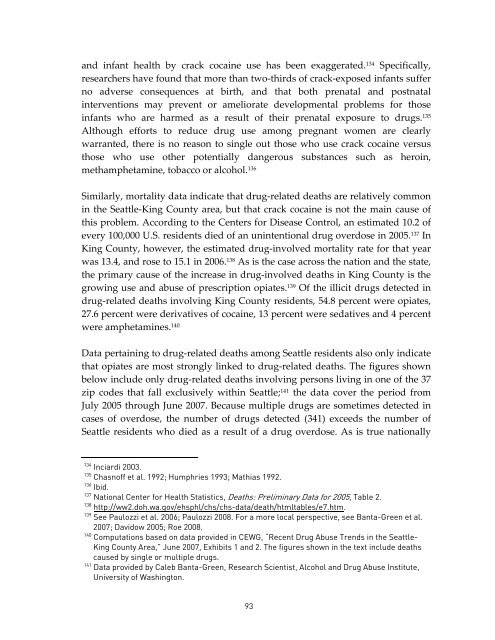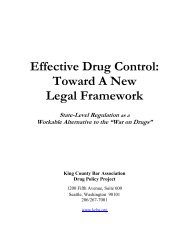RACE AND THE ENFORCEMENT OF DRUG DELIVERY LAWS IN ...
RACE AND THE ENFORCEMENT OF DRUG DELIVERY LAWS IN ...
RACE AND THE ENFORCEMENT OF DRUG DELIVERY LAWS IN ...
Create successful ePaper yourself
Turn your PDF publications into a flip-book with our unique Google optimized e-Paper software.
and infant health by crack cocaine use has been exaggerated. 134 Specifically,<br />
researchers have found that more than two-thirds of crack-exposed infants suffer<br />
no adverse consequences at birth, and that both prenatal and postnatal<br />
interventions may prevent or ameliorate developmental problems for those<br />
infants who are harmed as a result of their prenatal exposure to drugs. 135<br />
Although efforts to reduce drug use among pregnant women are clearly<br />
warranted, there is no reason to single out those who use crack cocaine versus<br />
those who use other potentially dangerous substances such as heroin,<br />
methamphetamine, tobacco or alcohol. 136<br />
Similarly, mortality data indicate that drug-related deaths are relatively common<br />
in the Seattle-King County area, but that crack cocaine is not the main cause of<br />
this problem. According to the Centers for Disease Control, an estimated 10.2 of<br />
every 100,000 U.S. residents died of an unintentional drug overdose in 2005. 137 In<br />
King County, however, the estimated drug-involved mortality rate for that year<br />
was 13.4, and rose to 15.1 in 2006. 138 As is the case across the nation and the state,<br />
the primary cause of the increase in drug-involved deaths in King County is the<br />
growing use and abuse of prescription opiates. 139 Of the illicit drugs detected in<br />
drug-related deaths involving King County residents, 54.8 percent were opiates,<br />
27.6 percent were derivatives of cocaine, 13 percent were sedatives and 4 percent<br />
were amphetamines. 140<br />
Data pertaining to drug-related deaths among Seattle residents also only indicate<br />
that opiates are most strongly linked to drug-related deaths. The figures shown<br />
below include only drug-related deaths involving persons living in one of the 37<br />
zip codes that fall exclusively within Seattle; 141 the data cover the period from<br />
July 2005 through June 2007. Because multiple drugs are sometimes detected in<br />
cases of overdose, the number of drugs detected (341) exceeds the number of<br />
Seattle residents who died as a result of a drug overdose. As is true nationally<br />
134 Inciardi 2003.<br />
135 Chasnoff et al. 1992; Humphries 1993; Mathias 1992.<br />
136 Ibid.<br />
137<br />
National Center for Health Statistics, Deaths: Preliminary Data for 2005, Table 2.<br />
138 http://ww2.doh.wa.gov/ehsphl/chs/chs-data/death/htmltables/e7.htm.<br />
139 See Paulozzi et al. 2006; Paulozzi 2008. For a more local perspective, see Banta-Green et al.<br />
2007; Davidow 2005; Roe 2008.<br />
140<br />
Computations based on data provided in CEWG, “Recent Drug Abuse Trends in the Seattle-<br />
King County Area,” June 2007, Exhibits 1 and 2. The figures shown in the text include deaths<br />
caused by single or multiple drugs.<br />
141 Data provided by Caleb Banta-Green, Research Scientist, Alcohol and Drug Abuse Institute,<br />
University of Washington.<br />
93

















